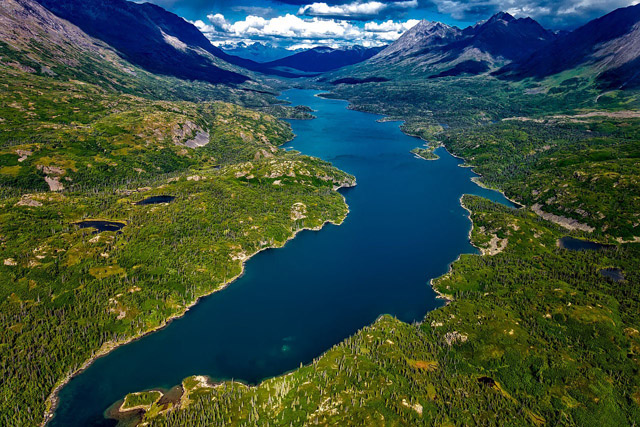
It’s there on the number plates – ‘Alaska: the last frontier.’
It’s there in the small towns where the laundromat (and its showers) does a roaring trade, because many people live in ‘dry’ cabins (i.e. without running water.)
It’s there in the stories you hear – yes, a bear did come into a house in suburban Anchorage and help itself to pancake mix and cream cheese (we heard that story first hand.)
It’s there in the reference to the ‘lower 48’; ie the other states of the US, implying that Alaska is a state that’s set apart.
A land apart
Yes, Alaska is geographically isolated from the rest of the US. Two and a half states of Texas could fit into Alaska’s area. It has an enormous coastline, and large swathes of land are not farmed or forested, but covered in boreal forest, mountain ranges and lakes.
Its population is small in number, less than a million, and its roading network is such that most of it can be travelled in a few weeks. Apart from the two main cities – Anchorage and Fairbanks - most of its population lives in the south in small towns or in the countryside, along the roads or in ports along the coastline.
So it’s no wonder Alaskans see their state as largely comprising wilderness – because it does. They live on the edge of the wilderness, or in it, so naturally they have a frontier mentality.
If they live in a city they may well have a job or recreational activities that take them into the wilderness – Anchorage is the float plane capital of the world.
They have ATVs to explore in the summer, and snow mobiles for cross-country travel in the winter.
Visiting the Wilderness
I was very privileged to spend three weeks in Alaska recently. We travelled by 4WD truck camper around most of the road network, getting into both out of the way places and favoured tourist destinations.
With friends we journeyed up the Dalton Highway to well above the Arctic Circle, camping along the way, almost to the Arctic Ocean. (It was summer – and not a winter journey as featured in ‘The Ice-truckers’ TV programme.)
We joined the 600,000 plus visitors who go to Denali National Park during the four summer months, hoping to see ‘the big one’ – the highest mountain in North America – and see the wildlife.
We ventured into the actual wilderness by doing some short walks – and were always on the look-out for wildlife.
Into the wild
But we didn’t really go ‘into the wild’ in the way that some have done, who have been drawn by the mystique of Alaska, its pioneering history, and its remoteness, as a place where they can have a wilderness experience.
While in Alaska, I read the tragic story of a young man who after graduating left the successful middle-class upbringing his parents had given him. He travelled across country for some time, living a roving life, working here and there, before heading to Alaska, and going into the wild to live.
From his diaries it appears he managed much of day to day living, but it was after eating something that may have had mould on it, that he became ill. He was holed up in an old abandoned bus for some time, and eventually died, a short time before hunters came by the bus.
As well as those who want a simpler, more natural life, there are those who want to find themselves, or who go in search of some spiritual experience.
Going on a pilgrimage
They are not always on their own – one man who described himself as a pilgrim (as per John Bunyan’s, ‘Pilgrim’s Progress’) took his wife and 14 children into a wilderness area in order to follow the Lord and raise his family according to the Bible and Bunyan’s story. He ran foul of national park authorities, and as he descended into madness, his family suffered. That story didn’t end well either.
Living in or co-existing with the wilderness involves a set of skills, experience and practical nous – and a lot of hard work, especially during an Alaskan winter. Any romantic notion of a wilderness experience is soon overtaken by the realities of daily living.
Yet the yearning to be in tune with the natural world, and for a simple life, is an ageless one. (So many people, who when they heard we were going to visit Alaska, said they would love to do the same.)
But Alaska, as wilderness, is so much more than a tourist destination. The spiritual desire for ‘time out’ from modern life, and a longing for a closer walk with God that being in the natural world can offer, continually draws Christians, and not only to Alaska.
Jesus in the wilderness
Jesus spent 40 days in the wilderness before he began his ministry. He also drew aside during his three years on the road, into ‘a quiet place’ for prayer, alternating such times with his busy days of healing and teaching the crowds, or spending time with his disciples.
Retreating to be recharged in a place where it’s not a daily battle to survive is a spiritual necessity for many.
Returning to life in the ‘world’
We had three weeks in Alaska before picking up responsibilities again. Our time in the wilderness was truly a wonderful ‘time out’, but it did not begin a time of withdrawal from the world.
Christians are sent out into the world. To withdraw from the world to seek some kind of wilderness experience is often ultimately a selfish pursuit, even if the goal is some kind of spiritual or cosmic experience, or lifestyle choice.
Our God is the one who came to earth to live – with his people. Our call is to do the same.
.jpg) Liz Hay is a NZ senior writer from Castle Hill (Christchurch, Arthur’s Pass), now enjoying being home, and savouring the spring in another wonderful part of God’s world.
Liz Hay is a NZ senior writer from Castle Hill (Christchurch, Arthur’s Pass), now enjoying being home, and savouring the spring in another wonderful part of God’s world.

Liz Hay rejoices in living in a beautiful part of God’s creation in a high country mountain basin; and she also rejoices in hearing stories of God at work in people’s lives. One of her favourite activities is reading fascinating biographies that illustrate the wonderful ways God works uniquely with each person.